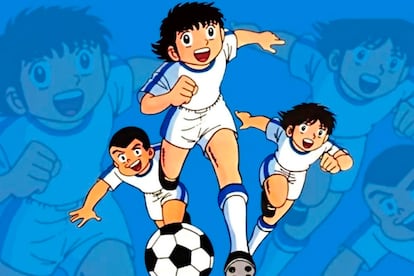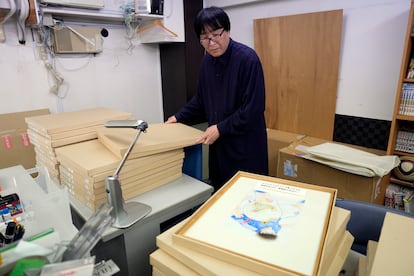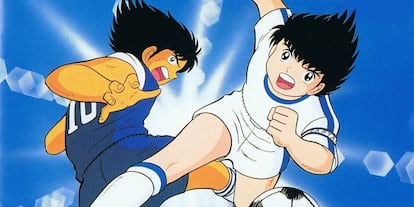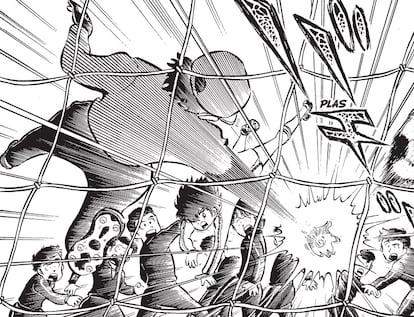Oliver owes his life to the ball. For the glory, the triumphs, the friends. But, first, in the most literal sense. When a truck hit him when he was little, the sphere stood in the way and stopped the hit. Like Benji. Since then, the boy and the leather became inseparable. And the boy returned the favor by treating him with more affection than anyone else. Although, in those first pages of the manga Captain Tsubasawhich Yoichi Takahashi created back in 1980, another love affair was born at the same time: that of an entire generation with a drawn character.
Perhaps that is why the midfielder has endured almost 45 years on the pitch. Even for him, however, the time has come to hang up his boots. At least, on paper: a few weeks ago the Japanese publisher Shueisha published the latest issue of the saga. Takahashi had already announced the end, due to the excessive physical effort it requires among other reasons. The author added, of course, that he will continue publishing sketches and new materials online. It can’t be easy to sit Oliver Atom on the bench forever.
Even so, the news filled millions of fans with nostalgia. Those who discovered that, in real life, the combination shot causes more injuries than goals; those who waited, patient, for the parade of thoughts of all the characters every time the ball was about to cross the goal line; those who dreamed of emulating Oliver while the first parties sent them just the opposite signal; those who calculated that the fields in the animated series must have measured about 18 kilometers, judging by how long it took the players to cross them; or even those who preferred Tom, Julian or Mark Lenders over the protagonist. Because, in the end, even Oliver Atom’s rivals (Tsubasa Ozora, in the original) always ended up being his friends.
“It marked an era,” says Ignasi Estapé Ferré, executive editor of Planeta, which is relaunching the original mangas on the market and has sold some 50,000 copies. Thus, in addition to those born in the eighties, he intends to hook his children. A recent video game and the return of animated series to platforms such as Neox or Netflix have returned the chants for the Nankatsu team to the stands. T-shirts, sneakers, sticker albums or toys also circulate, not to mention the wave of unofficial products. “In recent years there has been a resurgence of interest. It is undeniable,” reads The magicians of the ball. All about Oliver and Benji (Diabolo), by Miguel Martínez and Néstor Rubio, a kind of tribute bible that was published last year.

And Takahashi, at first, preferred other sports, just like almost all of Japan. He fantasized about becoming a baseball star. Until he saw the 1978 World Cup in Argentina. Apparently, he fell in love with that free game and the local striker, Mario Kempes. Although it has also been said that Atom is inspired by Kazuyoshi Miura, eternal Japanese striker. In any case, starting in 1980, through manga, Takahashi spread his new passion to an entire country. “It is known that Japan professionalized football and created its federation thanks to the inspiration that it provided Captain Tsubasa for thousands of young people,” says Martínez. The statues scattered throughout the Tokyo neighborhood of Yotsugi are further proof of the impact. Worldwide, it is estimated that the manga has sold more than 90 million copies.
“The story is based on a very basic premise, the evolution of Oliver as a footballer and the rest of his teammates, maintaining a dynamic that works well: a new rival appears with greater skill and you have to surpass him,” adds the author. Specifically, the plot began with the move of Oliver and his mother from Tokyo to Shizuoka. And from then on, the little boy’s dream of becoming the best soccer player on the planet continued.
Although, between bicycle kicks, unbeatable goalkeepers and epic comebacks, football offered Takahashi a perfect pass to address other topics: disappointment, effort, self-love, team spirit or self-improvement. And even dramas such as paternal absence, poverty or the heart condition that limited Julian Ross, as talented and loved as Oliver by readers and viewers. Such a lineup won over the public right away. And by a landslide. So much so that, in 1983, he already had his cartoon adaptation. This is how he arrived in Europe, and especially in Spain, in 1990.

“Until then, cartoons offered very similar series, quite light or even with self-contained chapters, which had a little message to be a better person at the end. Oliver y Benji It was a more exciting approach, with characters that developed the plot fluidly, which was engaging to know what would happen to them,” Rubio reflects. As proof, the flood of letters that Telecinco received signed by families begging the network to change the broadcast schedule. At 8:30 p.m. it coincided with the news, and there was no one who could overcome the insistence of the little ones. Championsas the series became known, contributed to the boom of the anime in those years in Spain with several decisive goals. And he left the goal open for the arrival of other comics and series about football, such as Supergoal, Inazuma Eleven, Blue Lock or the best seller The very footballers.
Stars like Andrés Iniesta or Fernando Torres confessed their passion for Oliver y Benji. And Atom himself demonstrated his love for Spain, since in the plot he ended up wearing the Barcelona shirt. Although the arrival of the series in 1990 brought with it two other surprises: the legendary introductory song takes advantage of the bases that in Italy were used for the drawings of Lupin III, changing the letter. And his interpreter, Miguel Morant, never saw his name recognized in the credits. “I don’t know in whose hands exactly the distribution rights of this song will be now,” he confesses in The magicians of the ball.
In general, the small screen revealed to Europe a universe of goalkeepers capable of jumping from one post to another thanks to karate, acrobat brothers who scored with blows from an “infernal catapult” and forwards hardened in poverty who trusted their rescue to the tiger’s shot. . And the repeated confrontations between all of them with epic blows and theatrical pauses: a famous shot by Oliver crossed the entire field and left the ball spinning on the ground for a long time before entering. An Italian scholar estimated that the soccer players in the series traveled about 250 kilometers per game and must have moved at about 150 km/h.

In the multiple sequels to the original story, Takahashi collected the love that his creatures received outside of Japan and sent them to play in Brazil or the old continent. He included the unknown Reggiana, where Mark Lenders ended up on loan as he did not show an ideal condition to stay at Juventus. In the youth World Cups and Olympic Games in Madrid (!), Oliver and company also defeated the best teams on the planet, from the Argentine Luis Díaz to the French Pierre and Napoleón, from the Mexican goalkeeper Ricardo Espadas to the Uruguayan Ramón Victorino. Although, at least in the manga, the characters never competed in the main World Cup.
The series did not even host a Women’s World Cup. For a referee with today’s eyes, in fact, the treatment of women in the manga would deserve at least a yellow card. Mainly, they encourage the players or stand out as their “girlfriend” or “mother.” “It must be put in context, the original series was published between 1981 and 1988. Things were understood in a different way,” evidences Ignasi Estapé Ferré. And the editor points out that, while the nostalgic audience is mostly male, the new audiences are more spread out. A new challenge pending for Oliver Atom. Excluding half the world, in the 21st century, would be an own goal.

Subscribe to continue reading
Read without limits
_

